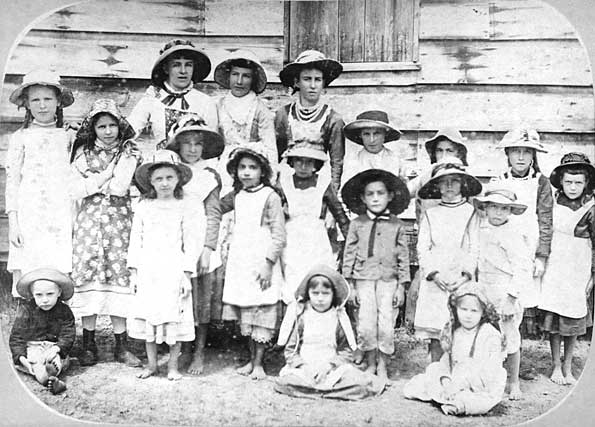Description
This is an 1885 photograph of students and three teachers of the Clyde Creek State School near Gladstone, Queensland. The group is standing outside, against a wall made of wide wooden planks, probably part of the school. Most of the children are young girls, who wear protective aprons over their clothes. One of the teachers is very young and is probably a pupil-teacher.
Educational value
- This asset shows female teachers - about 50 per cent of all teachers in Queensland in the last 25 years of the 19th century were women; in one-teacher schools, their role encompassed teaching all the children and infants, as well as being the head teacher; married women were actively discouraged from teaching, as the prevailing belief was that they were taking jobs from others who needed the opportunity to work.
- It portrays at least one and probably two pupil-teachers - there was no teachers' training college in Queensland until 1914, so teachers learned on the job by teaching under supervision; in 1885, pupil-teachers made up about 35 per cent of all Queensland teachers, and the system continued until it was phased out between 1923 and 1935.
- It depicts 16 students of various ages - indicating that this is likely to be an entire one-teacher provisional school, rather than a single class of a larger school; such schools had an attendance of between 12 and 30 students and operated as a provisional school until the numbers were large enough for a state school to be established.
- It shows weatherboards that have not been painted, stains that have leached out of the nails into the wood and a roughly-framed window covered in by wooden planks - this reveals the rudimentary construction of the school; buildings in provisional schools were provided by the parents.
- It shows a disproportionate number of girls in the school - this suggests that most boys in the 1880s would have been needed to work on the farms, and that only girls could be spared to go to school; by 1900, however, almost all Queensland children, both boys and girls, were literate.
- It shows the sort of clothing worn by children who came from families who were not well off - the children mostly wear plain fabrics, no-frills designs, protective aprons and no footwear; a girl whose overall is made of printed, coloured cloth, and who wears boots, stands out in this group; by 1885 the gold in the Gladstone area was gone, the area relied on cattle farming and prosperity was limited.
